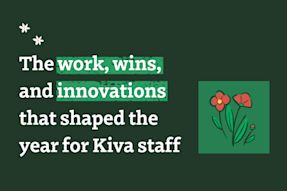Their super-efficient clean cookstoves may not produce much smoke, but a Kenya-based company that manufactures them is on fire.
BURN, which launched in 2014, recently secured investment of 10M Euros, following several rounds of catalytic funding from Kiva. The company’s new partnership with Nordic Bank, Modern Cooking Facility for Africa and other institutions will allow BURN to bring more access to its affordable electric cookstoves than ever before.
How many lives can be improved with 10M Euros? The projected impact for this funding is expected to:
Deliver 456,000 clean cookstoves and other e-cooking products
Benefit 2 million people in 5 sub-Saharan African countries, including Kenya, the Democratic Republic of Congo (DRC), and Tanzania
Create as many as 2,200 jobs
The investment has set BURN’s capacity ablaze, and it was all sparked by a Kiva loan.
What is catalytic funding?

Catalytic funding unlocks much-needed capital for social enterprises and businesses aiming to address global issues like poverty, climate change, economic inequality, and education. These businesses tend to be high-risk, and it can be challenging to obtain the funding necessary to launch and grow, especially in developing countries.
These companies have been referred to as the “missing middle”, as they are too big to receive microfinance loans, yet too small for traditional banks. Their financial exclusion keeps viable ventures from taking hold and slows economic development where it’s needed most.
Kiva invests in these kinds of companies at an early stage, assuming some of the financial risk as they prepare to scale. Providing vital funding at the beginning of their journey serves as a catalyst that helps these high-impact social enterprises build a scalable foundation and a financial track record. This can help entice larger investors to come forward, so that the organizations can attract more outside funding and increase their impact.
For instance, BURN received its first Kiva loan of $100,000 in 2019, enabling the company to boost production to 40,000 cookstoves per month during the holiday season, when demand is at its highest. The following year, more than 100,000 cookstoves were distributed throughout Kenya and other sub-Saharan African communities, fueling BURN’s profits while saving households over $25M in coal and wood expenses — not to mention keeping as much as a million tons of CO2 emissions out of the atmosphere.
Another round of Kiva funding came in August 2020, when BURN requested $200,000 to maintain operations during the COVID-19 pandemic. That loan helped the company introduce its Jikokoa charcoal cookstove, a version of the popular ceramic jiko stove used in Kenya that reduces smoke and soot by 60 percent. The Jikokoa not only decreases dangerous household air pollution and improves health outcomes, it saves families hundreds of dollars a year and frees up valuable time.

These loans from Kiva Labs enabled BURN to continue to scale and improve lives, and helped set the stage for their monumental $10M investment in October 2023.
What are other examples of catalytic funding?
Kiva Labs, along with Kiva lenders, continues to fill in the gaps for the “missing middle.” Recent projects include Nuru, a solar energy developer in the DRC, where war and poverty make it difficult to access electricity (only 10 percent of Congolese citizens have reliable power). Nuru—which means “light” in Swahili—manufactures solar mini–grids and creates infrastructure that bring renewable energy sources to rural communities. A $100K “bridge loan” from Kiva recently helped the social enterprise grow before completing a round of Series B funding of USD$60M, allowing it to scale from serving 50,000 people to five million by 2024.
Food security and agriculture is another area where investment can mobilize positive impact. In Ghana, small farmers make up 23 percent of the gross domestic product, but sustaining productivity and maximizing economic potential is limited. The “agritech” company Complete Farmer connects farmers with global food buyers and provides tools to improve crops through a simple online platform created by founder Desmond Koney. Kiva found Koney’s business plan so promising it provided USD$50K in 2022, helping catalyze $10.4M in Series A funding. Kiva plans to administer another $300K to Complete Farmer by the end of 2023 (you can contribute directly to this loan here!). The company now serves 12,000 farmers and expects to expand exponentially in its new phase of growth.
In 2022, Kiva made its largest social enterprise loan ever to facilitate a tremendous example of catalytic funding. The Alternative Technologies Energy Group, better known as Altech, received a USD$500K loan to distribute home solar products and clean cookstoves to 125,000 households in the DRC. Since then, the company has raised more than USD$18M in growth capital and is now positioned to open 30 new sales outlets in rural areas that will distribute 180,000 new solar products to an estimated 900,000 people, bringing more affordable energy options to one of the world’s most under-electrified countries and providing thousands of jobs to Congolese youth.
It’s all about ‘follow-on’ funding
In these examples as well as BURN’s latest capital raise, early investment from Kiva Labs helped these companies reach the next stage in funding. For each dollar lent by Kiva, these “missing middle” ventures received five more in “follow-on” funding from additional sources—meaning that $5.7M in Kiva loans to social enterprises has translated into $26M in new capital since the program’s inception.
Businesses in 37 countries have benefited from Kiva social enterprise loans, which are powered by partnerships with mission-aligned investors, corporations and foundations as well as individual lenders. The program makes it possible that from anywhere in the world, with as little as $25, anyone can be a catalyst that creates positive impact, supports sustainable economic development and improves lives.
You can lend to a social enterprise here.















